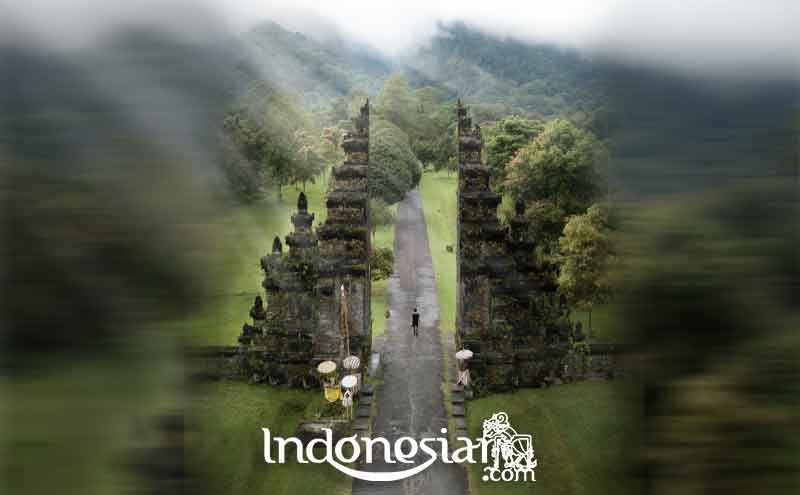Penataran Temple is located in Penataran village, Nglegok sub-district, Blitar, East Java. This temple is located at an altitude of 450 meters above sea level on the southwest slope of Mount Kelud.
Penataran temple is a temple with Hindu nuances that has existed since the kingdom of Kediri and was used until the era of the Majapahit kingdom and is the largest Hindu temple complex in East Java with an area of 12,946 m2.
Penataran Temple was discovered by Sir Stamford Rafless in 1815 when he was a lieutenant governor general during the British colonial era in Indonesia.
Facts and History of Penataran Temple
Apart from the historical facts above, we summarize the facts and history of the upgrading temples in Blitar.
1. The architecture of the Penataran Temple
The architecture of the upgrading temple is the same as most temples in other areas of East Java, which are arranged linearly and irregularly which are grouped into three parts, namely the front, middle and back yard.
On the front page, there are two Dwapala arches welcoming at the main gate, Archa Dwapala is believed to be the doorman and is known to the local community by the name Reco Petung which dates from 1242 Saka or 1320 AD.
In addition, on the front yard of the temple you can see the grand bale and the pavilion which are usually used as a gathering place for traditional elders or for deliberation.
The second part of the Penataran Temple complex is the central courtyard. Here, you can find two Dwarapala statues, 6 remaining buildings, a Dragon Temple and a brick foundation to the east of the central courtyard.
The third part of the Penataran Temple complex is the backyard. the backyard has a higher location than the front page and middle page. Here, you can see 9 pieces of former buildings with irregular positions, the Palah inscription in the form of a lingapala and the rest of the buildings that have reliefs that tell of the temple with a height of 1 meter.
2. The largest temple in East Java
Penataran Temple is the largest and largest Hindu temple in East Java, has a complex area of around 12,946 m2 and is located 450 meters above sea level on the slope of Kelud Mountain.
3. Initially known as Palah Temple
The upgrading temple was originally known as Candi Palah based on inscriptions stored in the temple. From the inscription, it is stated that the name Palah temple is a temple for worship.
However, over time the name palah temple became no longer familiar and changed to Candi Penataran because it is located in Penataran Village, Nglegok District, Blitar.
4. Hunted by Archaeologists
Penataran Temple or Palah Temple was built in 1194 by Raja Çrnga (Syrenggra) with the title Sri Maharaja Sri Sarweqwara Triwikramawataranindita Çrengalancana Digwijayottungadewa. King Çrnga ruled the kingdom of Kediri between 1190 and 1200, as a mountain temple for worship ceremonies in order to neutralize or avoid the dangers caused by the frequent eruption of Mount Kelud.
This Penataran temple still stands firmly and has not yet received reconstruction so that its authenticity is still very well preserved. Therefore, this temple is much sought after by archaeologists to do research and reveal more in the mysteries and history stored at that time.
5. Relics of Kediri Kingdom
This Penataran Temple was originally the beginning of its construction during the kingdom of Kediri. From the inscriptions in the temple it is estimated that this temple was built during the reign of King Srengga of the Kingdom of Kediri around 1200 AD. The kingdom of Kediri or Kadiri was present in the archipelago from 1045 AD to 1222 AD
The kingdom of Kediri is one of the largest kingdoms ever in the archipelago. Considering that the construction period was during the reign of the Kediri Kingdom, it is almost certain that several parts of the temple were built at that time.
6. Places of Worship Reject Mount Kelud Troops
Initially the Palah Temple or Penataran functioned as a place of worship to avoid the distress of the eruption of Mount Kelud. Mount Kelud is an active volcano with a unique eruption pattern.
Mount Kelud is even still active until now and last erupted in 2014 which spewed ash material that covered most of Java.
7. Where the Gajah Mada Palapa Oath took place
The Penataran temple was the most preferred place for King Hayam Wuruk and Mahapatih Gajahmada when traveling. From various stories it is known, Mahapatih Gajahmada took his oath “Palapa Oath” in this area of Penataran Temple.
In addition, Ken Arok’s ashes, the founder of the tumapel kingdom, which is the origin of the Singasari kingdom and the King of Majapahit, were also stored in this upgrading temple.
8. Built by Various Great Archipelago Kingdoms
The Penataran temple was originally built during the reign of the Kediri kingdom, after which it was added to the dragon temple building which is believed to have been built during the reign of Kartanegara who led the Singasari kingdom.
After Singashari collapsed, the Penataran temple was expanded again during the Jayanegara administration, which was continued by Tribuanatunggadewi and Hayamwuruk. the three names are the great kings of the Majapahit kingdom.
Thus, the three major kingdoms in the archipelago left their mark in the magnificent building of the Penataran Temple.
So, those are the history and historical facts of Penataran Temple. If you are on vacation in Blitar, don’t forget to visit this temple.































